Have you ever felt thrilled by self bondage? It mixes self-discovery and controlled restraint. More than 15.7K social media posts show its growing popularity. People use it to dive into their deepest fantasies. Yet, this exciting activity needs careful thought. While it brings joy and deep psychological satisfaction, safety is key. Knowing how to stay safe and stimulated is vital for enjoying self bondage.
Starting this journey calls for good preparation. This article highlights key self bondage tips. They help you master self-restraint safely. You’ll learn to make your solo play safe, enjoyable, and filled with understanding.
Key Takeaways
- Self bondage offers a thrilling path to explore personal fantasies.
- Putting safety first is essential; knowing the risks matters a lot.
- With the right equipment and plans, your experience will be safer and more fun.
- Learning about different self bondage styles can create unique experiences.
- Always have a backup plan and keep emergency tools close by.
Introduction to Self Bondage
Self bondage opens a world of exploration and personal fulfillment. People engage in self restraint to explore control and fantasies. This unique bondage form lets you explore limits and creativity at your pace, no partner needed.
Many explore self bondage for pleasure and self-understanding. It helps connect with sensations and desires in an empowering way.
Self bondage and partner bondage differ greatly. Self bondage offers freedom to experiment with preferences and boundaries on your own. As skills develop, the connection to your body can enhance emotional and sexual exploration.
Practicing self bondage calls for a commitment to safety and mindfulness. It’s essential to set your own limits, plan escapes, and learn about equipment. As you start this journey, remember the excitement of self discovery and the importance of being safe.
Understanding the Types of Self Bondage
Self bondage has two main types: sensual and strict. Each kind gives different emotional and mental feelings. Knowing these differences helps make your sessions better and connects you more to your play.
Sensual Self Bondage
Sensual self bondage focuses on mental stimulation and the feel of being tied up but easy to escape. It uses loose knots and escape options you can quickly get to. This method is great for beginners. It lets you explore your desires safely.
Strict Self Bondage
Strict self bondage is tougher and more challenging. It uses complicated ties and makes escaping hard. This ups the excitement and risk. People doing strict self bondage often mix in other fetishes, making it more intense. This way, they test their limits and discover more about themselves.

| Aspect | Sensual Self Bondage | Strict Self Bondage |
|---|---|---|
| Focus | Psychological stimulation | Physical challenge and thrill |
| Knot Tightness | Loose and accessible | Tight and complex |
| Risk Level | Minimal | Higher |
| Escapability | Quick escape options | Limited escape options |
| Common Pairing | Intimate exploration | Other fetishes (e.g., humiliation) |
Knowing about self bondage types helps you guide your sessions. It lets you adjust them to match what you like and feel comfortable with.
The Importance of Safety in Self Bondage
Engaging in self bondage is exciting, yet safety must come first. Knowing the risks of self bondage helps you avoid dangers while still having fun. By recognizing common risks and your limits, you can use self restraint safety tips effectively. This ensures both safety and enjoyment.
Common Risks to Consider
Self bondage comes with several risks. Being aware of these makes your session safer:
- Blood Circulation Issues: Tight restraints can reduce blood flow, causing numbness or loss of circulation.
- Nerve Damage: Long-term pressure on nerves may lead to lasting damage without careful measures.
- Suffocation and Asphyxiation: Using gags or non-breathable restraints increases suffocation risk, especially alone.
- Dehydration and Fatigue: Bondage while dehydrated or tired can make you dizzy or faint.
- Panic Attacks: Lacking a clear escape plan could trigger panic, raising injury risk.
Physical Limitations and Awareness
Understanding your body is key for safe self bondage. Before starting, know your physical limits and health issues. Being informed helps you make safe choices:
- Listen to Your Body: Pay attention to comfort and signs of distress.
- Start Slowly: New to this? Use simple restraints to avoid injury.
- Regular Gear Checks: Always check your gear for damage to stay safe.
Taking these steps is crucial for self bondage safety. Each experience can be rewarding if done with body awareness and respect.
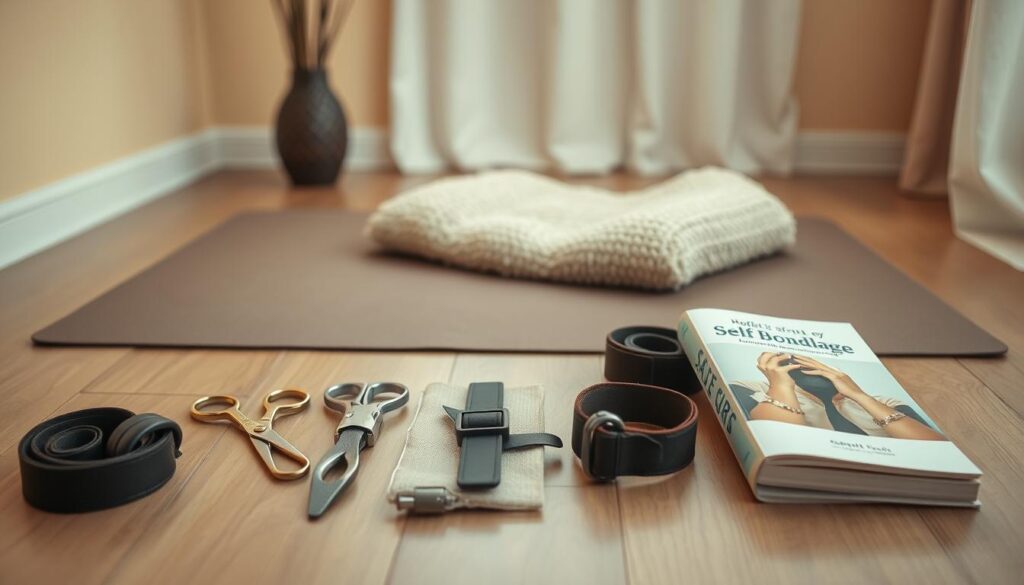
Self Bondage Simple Tips to Have Fun and Stay Safe
Exploring self bondage can be both exciting and calming when done carefully. Here are some self bondage tips to make sure you have fun and stay safe.
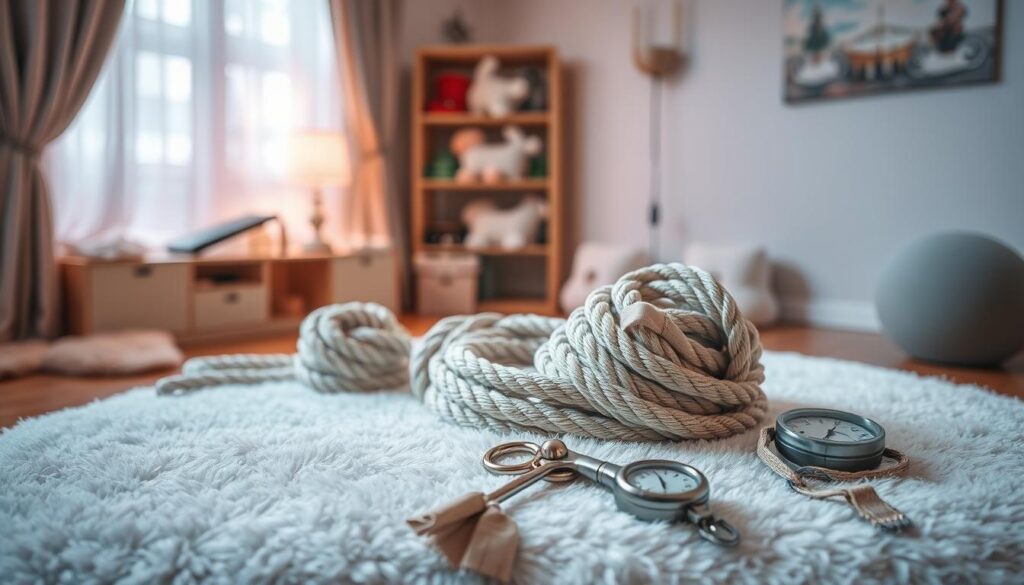
Begin with safe self restraint, especially if you’re new. About 80% of people advise using looser ties for safety as you learn. It’s also crucial to avoid methods that could block your breathing or hurt your neck. This focus on safety helps you enjoy your time more.
- Always have an escape plan ready before you start. Nearly 90% of those who try self bondage see this as vital. This way, you can quickly get out if needed.
- Pick safe materials to use. Around 60% prefer buying from trusted shops to lower risk.
- Starting with lighter bonds is smart. Research suggests 73% of newbies keep their hands free in the beginning. This makes managing by yourself easier.
Knowing the risks is key. For instance, 75% worry about hurting their circulation or nerves. Using soft materials like scarves can cut down on discomfort, as 61% have found it helpful.
Adding fun solo play tips can really improve your time. Half of the users include vibrators for extra thrill, which keeps it exciting and safe.
Mindfulness and careful preparation are crucial. Putting these self bondage tips to use ensures a great time. It puts your safety and enjoyment first.
Planning Your Self Bondage Session
Planning well is key for a fun self bondage time, keeping safety first. Knowing what gear you need and having a safe way out makes it better. Here are some tips for a smooth session.
Gathering Necessary Equipment
Before you start, make sure you have everything you need. You might need:
- Ropes or cuffs
- Safety scissors or bolt cutters
- A cell phone for emergencies
- A timer to keep track of time
- Water to drink
Keep these tools close to handle emergencies quickly. Good planning lets you relax more and enjoy self bondage.
Setting Up Your Escape Plan
Having a smart escape plan is very important for staying safe. Start with a clear way out for help if needed. Make sure you have a few ways to get free. Think about these tips:
- Put emergency keys or tools where you can get them easily
- Make sure the area is well-lit
- Go over your checklist, like checking gas, pets, and doors
These steps give you confidence to enjoy your self bondage session. With the right gear and escape plan, you’re set for a safe, fun experience.
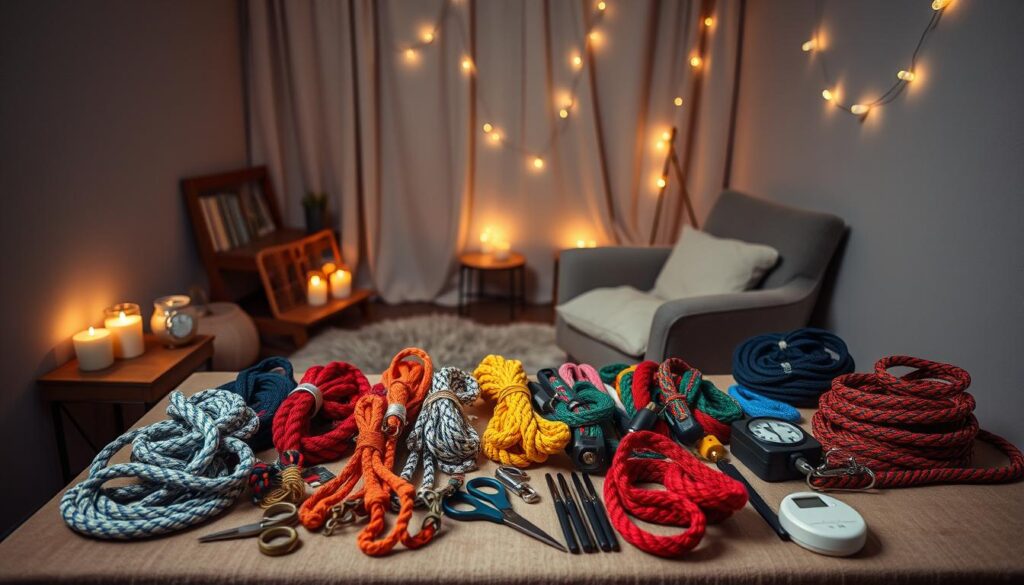
Choosing the Right Restraints
When you step into self bondage, picking the right restraints is key for fun. You’ll find gear for all comfort levels and interests. This part will go over your options, helping both newbies and experts.
Types of Restraints: Rope, Chains, and More
Self bondage comes in many materials and styles. Here’s a list of popular gear:
- Rope: It’s flexible for both comfort and creativity. There are lots of online guides to learn knots.
- Chains: They feel very restricting and strong. But, they’re not so comfy.
- Plastic Wrap: A good start for new explorers without spending a lot. Just watch out for dehydration.
- Duct Tape: It’s simple to use but might be too tight. Look for gentler options to avoid skin issues.
- Handcuffs: These are easy and offer a mix of control and easy release. Perfect for beginners easing into self bondage.
Recommended Materials for Beginners
For starters in self bondage, aim for comfort and safety. Here’s what we suggest:
| Material | Pros | Cons |
|---|---|---|
| Soft Rope | It’s flexible and gentle, with a low chance of rubbing you wrong | But, you need to learn some knots |
| Silken Scarves | They’re soft on your skin and simple to work with | They might not keep things tight enough |
| Plastic Wrap | Setting it up is easy and cheap | But, it can dehydrate you and isn’t very tough |
| Velcro Cuffs | You can adjust them and take them off quickly. They’re also soft. | They might not feel as authentic |
| Fabric Restraints | They’re comfy and can look cool | They may not be tight enough for everyone |
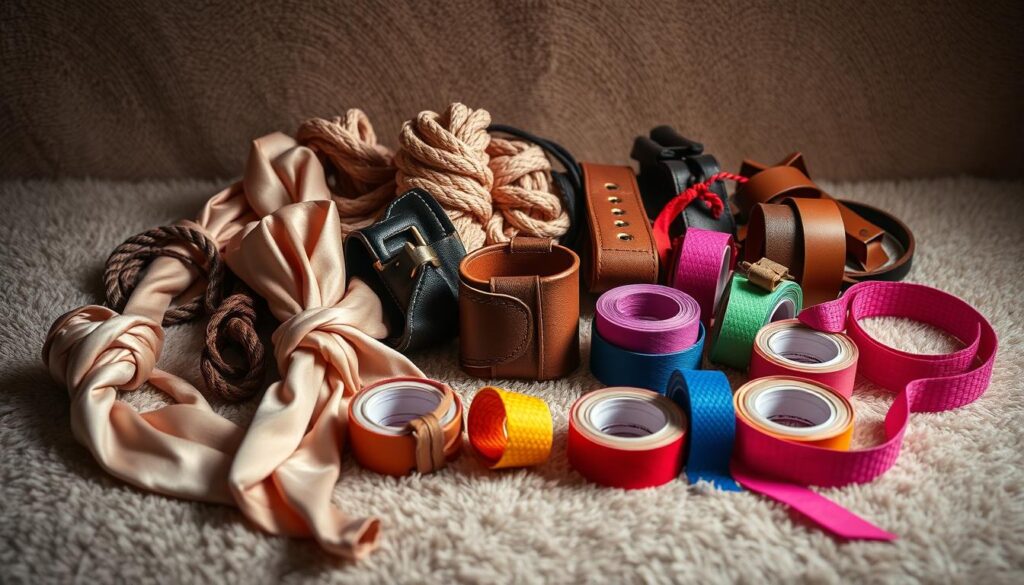
Safety first, always. As you explore self bondage, keep trying new things within safe limits.
Setting the Mood for Your Solo Play
Creating a great atmosphere makes your self bondage special. It’s all about getting into the activity while being safe and comfy. Things like lighting and sound can change your space. This lets you dive deeper into your exploration.
Lighting and Sound Considerations
How you light your space sets the whole vibe. Soft, dim lights make it cozy and welcoming. You might want to try:
- Fairy lights for a magical feel.
- Colored bulbs to change the mood.
- Candles for that warm, calming effect.
Sound is also key for a great experience in self bondage. A good playlist can really set the scene. The right sounds can get you more into it and help you relax. Make sure you won’t be disturbed by outside noise by picking a quiet spot.
Enhancing Sensory Experiences
To get the most out of self bondage, tap into all your senses. You could include:
- Fragrances: Scented candles or essential oils can bring out certain feelings.
- Textures: Try different fabrics like silk or fur to make touch more interesting.
- Temperature: Playing with warmth or coolness adds an extra spice to your session.
By focusing on these senses, your self bondage becomes much more fun. Remember to make your space comfy. It should excite your senses while keeping you safe and relaxed.
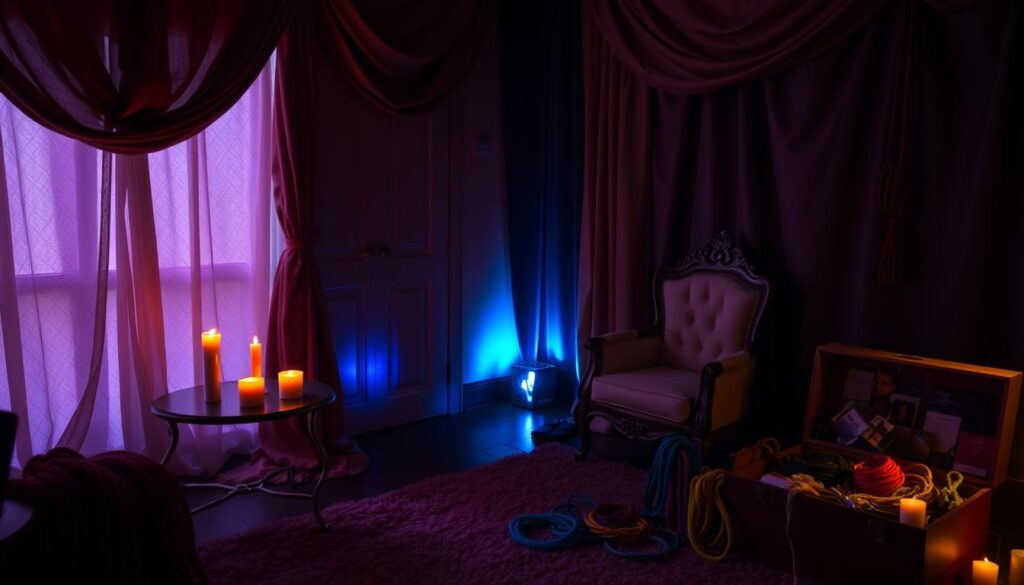
| Element | Purpose | Suggestions |
|---|---|---|
| Lighting | Set the mood and ambiance | Colored bulbs, fairy lights, candles |
| Sound | Enhance emotional connection | Playlists, ambient sounds |
| Fragrance | Evoke emotional responses | Scented candles, essential oils |
| Texture | Heighten tactile sensations | Silk, fur, various fabrics |
| Temperature | Add an exciting sensory layer | Warm/cool objects |
Techniques to Try in Self Bondage
Trying out self bondage is a thrilling journey. There are many ways to do it safely and with fun. You can start with easy knots, then try more complex ones as you get better. We’ll go into basic methods and timed release techniques to spice up your experiences.
Basic Knots and Harnesses
Learning simple knots is key to a good self bondage setup. Here are a few basic ones:
- Figure Eight Knot: A strong knot good for loops or harnesses.
- Bowline Knot: Easy to untie, making it great for quick escapes.
- Square Knot: It’s great for tying two rope ends together securely.
Ropes are versatile for self bondage, letting you make different snug fits. Comfort and security need to balance. Giving attention to how your body is tied can reduce discomfort. It’s smart to leave a little room, like 2 to 3 fingers’ worth, to keep blood flowing right.
Timed Release Methods
Adding a timer can make self bondage more thrilling. Here are some cool ideas:
- Ice Locks: Ice holds the knot. It melts over time, freeing you when you plan.
- Timed Locks: These gadgets unlock after a while. Always have a backup key close for safety.
Using timers means you can check how long you’re tied up. It adds fun and helps avoid being bound too long. Mixing simple knots with timers lets you enjoy and stay safe.
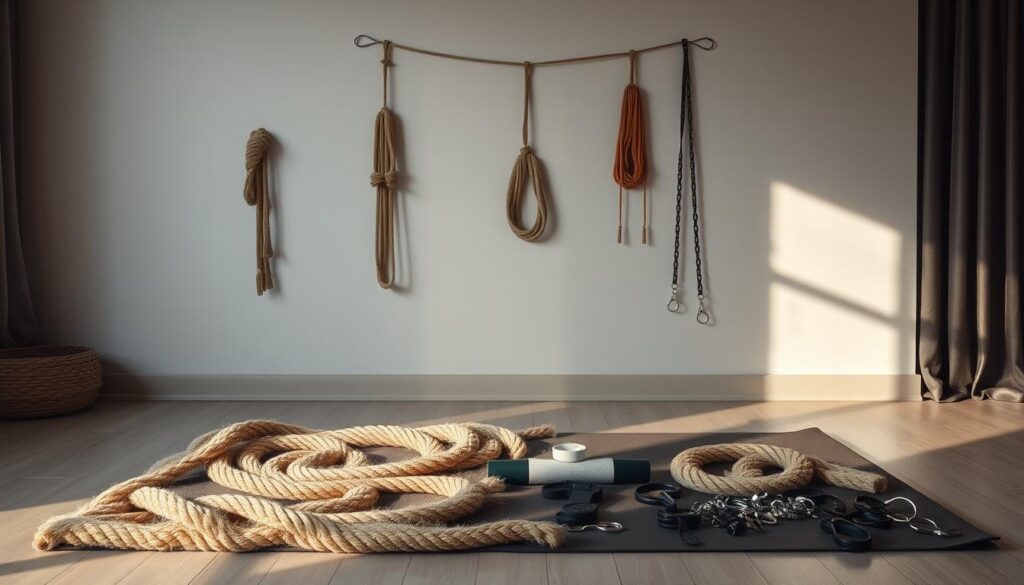
| Technique | Description | Safety Notes |
|---|---|---|
| Figure Eight Knot | Adjustable and secure, good for creating loops and harnesses. | Ensure it’s not too tight to avoid cutting off circulation. |
| Bowline Knot | Easy to untie after use, ideal for quick escapes. | Practice before use to gain confidence. |
| Ice Locks | Melts over time, providing gradual release. | Monitor closely, as melting ice can create water hazards. |
Trying these self bondage techniques can be deeply satisfying. It’s all about safety as you explore. Combining these methods as you get more skilled can open new paths in self discovery.
How to Safely Execute Self Bondage
Executing self bondage safely needs good planning and knowing your limits. A key part is to set time limits in self bondage. Having a set time keeps risks low and lets you enjoy safely.
Establishing a Time Limit
Time limits are crucial for safety and fun. Here’s how to manage your time well:
- Have a timer you can hear to signal the session’s end.
- Begin with short sessions and increase the time slowly as you feel more comfortable.
- Plan your self bondage when you feel most energetic and comfy.
Keeping Emergency Tools Accessible
Having safety gear and emergency tools for bondage close is vital. You should always have:
- Safety scissors or tools to free yourself quickly if needed.
- A phone or a device to call for help in a pinch.
- Materials for a quick release mechanism, attached to your restraints.
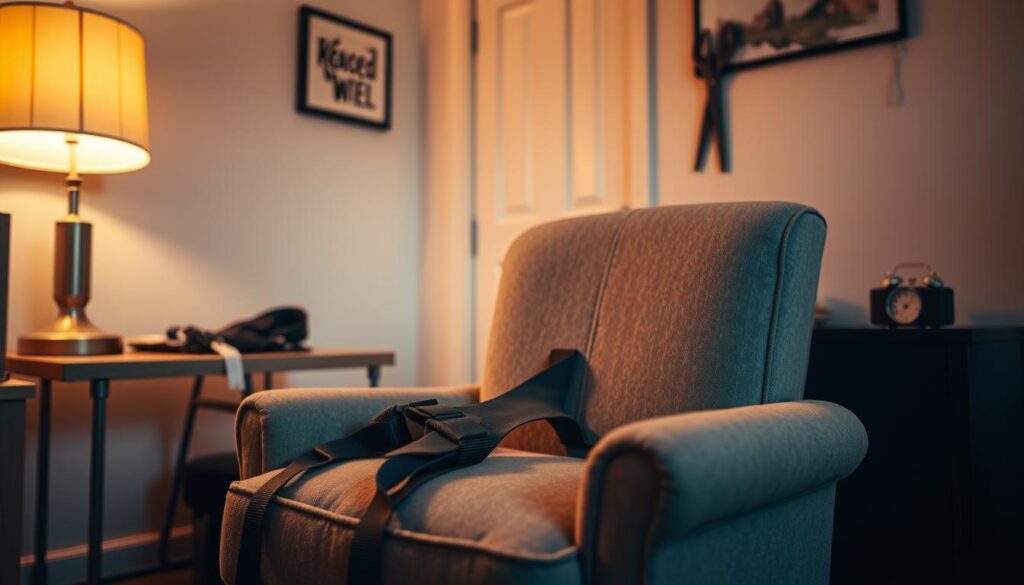
Being aware during your session is top priority. Stay calm and listen to your body. Enjoy while keeping your safety first for a fun, safe self-discovery journey.
| Emergency Tool | Purpose |
|---|---|
| Safety Scissors | Quickly cut away restraints in an emergency |
| Cell Phone | Call for assistance if needed |
| Quick Release Mechanism | Instant release from constraints during emergencies |
Considerations for Self Bondage Equipment
Self bondage is exciting but needs a focus on safety. Knowing what to avoid and having the right safety tools is key. These steps can make your experience safer and more fun.
What to Avoid: Dangerous Items and Methods
Some materials and methods are risky and can hurt you. Here’s what to stay away from:
- Zip ties: They tighten quickly and can stop blood flow.
- Restraints that are too tight: These can also cut off circulation, so watch them closely.
- Materials like plastic wrap: They make you overheat and can lead to dehydration.
- Techniques that make it hard to breathe or see: These are very dangerous and sometimes deadly.
- Complex escape methods: Getting free can be hard, especially with chains.
Essential Safety Tools You Should Have
Being ready is crucial for safety. Keep these tools close by:
- Safety scissors: They’re great for quickly getting out of tight spots.
- Bolt cutters: Perfect for emergency situations where restraints won’t budge.
- Spare keys: It’s smart to have an extra set to get out fast if needed.
- Timers: They help keep bondage play short to avoid any scares or harm.
- Emergency contact devices: Always have a way to call for help in an emergency.
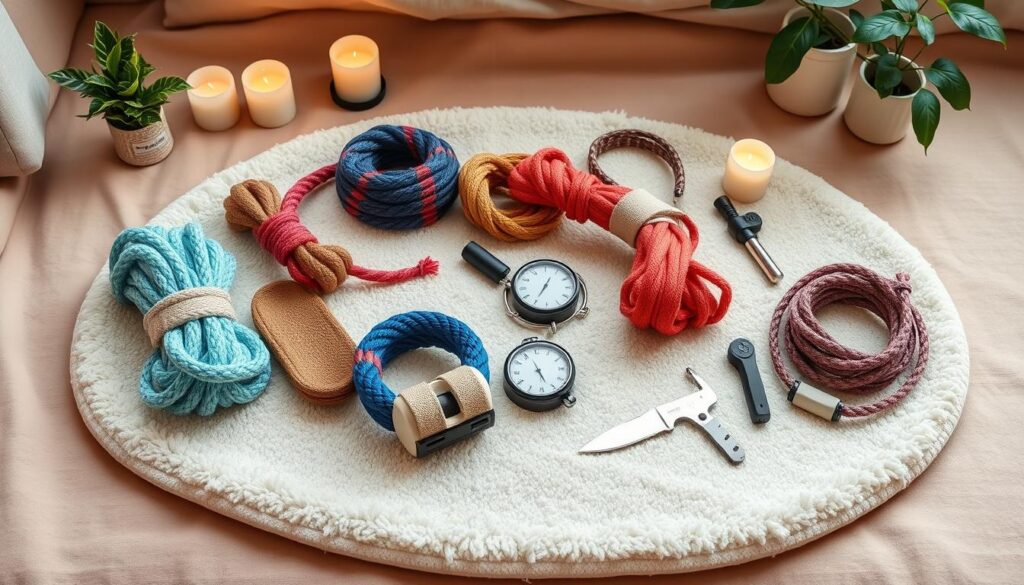
| Item | Purpose | Importance Level |
|---|---|---|
| Safety scissors | Quick release from restraints | High |
| Bolt cutters | Emergency release | High |
| Spare keys | Ensure quick exit | Medium |
| Timer | Limit session duration | Medium |
| Emergency contact device | Call for help | Medium |
By taking these steps, you can enjoy self bondage safely. Putting safety first makes the experience better and more secure.
Conclusion
Reflecting on your self bondage adventure is key. Remember to focus on safety, planning, and knowing yourself. This ensures your experience is both powerful and joyful.
Understanding your limits and trying new techniques is important. Always check how your body feels. Exploring your fantasies is great, but safety comes first. Learn what makes a safe space for your activities.
Enjoy the excitement of self-restraint, but be aware of the risks. Keep the advice from this article in mind. This way, you can enjoy self bondage safely. Your experiences will be both thrilling and careful.










